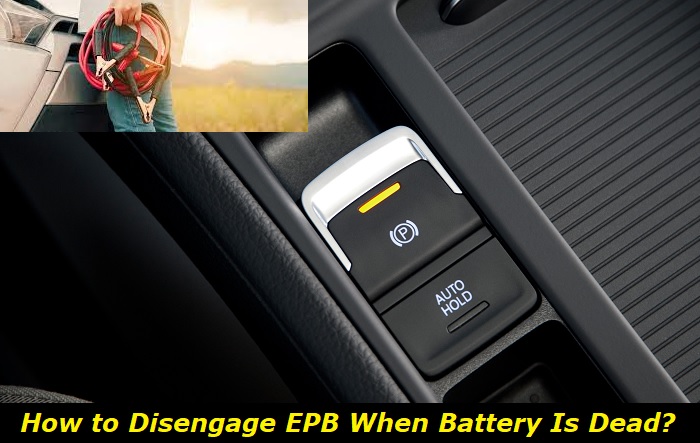Every car with an electric parking brake has an option to manually release the brake pads. Also, you can use a booster or another car for powering the vehicle. Sometimes, using the manual brake release function is so complicated that people choose to call a tow truck that can load their vehicle without the need for wheels to rotate.
No-power problems highlights
- Level of urgency:high
- DIY inspection:possible but complicated
- DIY repairs:possible but often complicated
- Can you drive?no
- Price of repairs:$50 - $250
- If ignored:no-start, nothing works
- Ways to fix:check the battery, connections, fuses

What's good and bad about electric parking brakes?
This feature looks cool and is good to use. You don't see that ugly parking brake lever in the central console of your vehicle. Now you can just push the button or engage a small good-looking level saying "P" and your car is in the parking brake. It means that the computer will activate the parking brake actuator and it will press the rear wheels pads to the brake rotor.
So, while in your previous vehicles, you needed to manually apply power to the lever to engage the brakes, now the work is done by actuators and electric mechanisms.
But there are several bad things about this technology that you should remember:
- you don't actually know when the parking brake is not that efficient or loose because you never contact with the wires and brake system itself;
- you can only apply the brake or release it when there is enough power to activate all the needed actuators;
- when the battery is low, you will not be able to release the brake and tow your vehicle or push It anywhere;
- the work of the system depends on electronics while the older parking brake system relied on your power which was more reliable.
Also, the electric parking brake gives you certain advantages. Now, your vehicle electronically controls the brake and you won't start driving until you release it. In manual parking brakes, driving with the brake engaged was a pretty common thing and this killed the rear brakes very fast due to severe friction and overheating. Now, your car will yell like crazy and you will release the brake.
Also, the system doesn't need any power - you just need to press a little button and the system will do all the work for you. This is what all new technologies are about and it's cool!
Can you manually release the parking brake if it's electric?
Almost all vehicles that are equipped with EPB which is an electric (or electronic) parking brake have the option of the manual release of the brake. It's important because if you have a serious function that totally relies on electric power, you need to have a manual option to control this function in case the battery dies.
So, here are some of the most common options to release the EPB manually:
- A lever under the dash. Very often, there is a lever under the dash of your car that you may use to engage and disengage the parking brake when there is no electric power. Just locate this lever now, when you still don't need it, to know its location when you are in trouble.
- A secret screw you need to turn. Also, many vehicles will have a secret screw somewhere between the driver's seat and the rear seat, at the bottom of the car. Also, in your tire kit, you will find a special tool that allows you to turn that secret screw. Doesn't sound like a good idea to me because the tool can be lost.
- A special latch under your vehicle. Also, some cars are known to have a special brake latch located under your vehicle. You can reach it and release the brake manually if needed. Very often, this is the most uncomfortable option.
- Some vehicles will have a secret lever to release the parking brake under the boot liner and carpet. Just pull the lever to get your wheels free.
You can check the driver's manual to make sure you know the location of that emergency lever that will help you get your car moving when needed. I know at least ten different locations of this thing, so I just listed the most common ones. It doesn't mean that your car will necessarily have exactly the same location as the brake release lever.
Attention! Don't ever apply the brake release lever without securing your car. Once you do this, the wheels will be free and the car may start rolling if placed on an incline. This may be dangerous for your health and life! Always make sure the vehicle is in P or in gear if manual and/or you put something in front of the wheels to avoid rolling!
How can you power the car to release the brake?
I told you about the emergency ways to get your car rolling freely. But there is one simple thing you can also do. You can power the car for some time to release the brake, start the engine, and do all the needed kinds of things even though your 12V battery is completely dead. And there are three ways you can do that:
1) Use the booster pack
You can buy a booster battery that offers high starting power and stable voltage for some time. The booster can power your battery and help you start the car or just release the brake. The booster pack doesn't cost a lot and is a good thing to have in your garage or even in the trunk.
Connect the booster to the battery and it will start charging the battery right away. Now you have enough power to unlock the brakes.
2) Connect your vehicle to another car's battery
For this, you will need jumping cables that you can buy in any car accessories store or online. I will not describe the process in detail, you can find a one-minute video tutorial for this. In short, you will connect the battery of a working vehicle to your car and it will give some power to the vehicle. You can now release the brake and even start the car.
When getting the cables, you shouldn't buy the cheapest option because there is a high risk that they just won't work.
3) Replacing or charging the battery
Another option is to replace your battery if it's completely dead. You can buy the new one and install it in your car. Now you have the opportunity to operate the brakes and use the functions of the vehicle to the full.
Alternatively, if the battery is not yet very old, you can recharge it using a car battery charger. Just connect the charger, choose the appropriate mode according to the battery type and size, and let it sit for a while.
Why isn't manual release always a good thing?
First of all, the manual release of the electric parking brake is often dangerous. You may not pay attention to the position of the transmission shifter and it may be in N. It means that when you release the brake, the car will inevitably roll if there is even a slight incline on the road.
Also, the system of the manual release is pretty complicated. Sometimes, you will just not be able to figure out how to use it. Car manufacturers often introduce it for specialists who tow vehicles and repair them. But it may be pretty challenging for a car owner.
Also, the range of situations when you can actually need the parking brake release is pretty narrow. For example, you may need this if you want to push the car with a dead battery into the garage or tow it with another vehicle (which is often forbidden due to transmission requirements).
In other cases, it's easier for you to charge or replace the battery rather than getting the driver's manual and trying to understand what kind of challenge your car manufacturer came up with to release the parking brake manually.
Final thoughts
Although the electric parking brake is quite common these days, you can still experience problems trying to disengage it when the battery is low or dead. In this article, I offered several ways you can do that without calling for roadside assistance or whatever. Choose the way that is more appropriate for you in the situation you are in and have full control over your vehicle even though it's featured with so many electric and electronic devices.
About the authors
The CarAraC research team is composed of seasoned auto mechanics and automotive industry professionals, including individuals with advanced degrees and certifications in their field. Our team members boast prestigious credentials, reflecting their extensive knowledge and skills. These qualifications include: IMI: Institute of the Motor Industry, ASE-Certified Master Automobile Technicians; Coventry University, Graduate of MA in Automotive Journalism; Politecnico di Torino, Italy, MS Automotive Engineering; Ss. Cyril and Methodius University in Skopje, Mechanical University in Skopje; TOC Automotive College; DHA Suffa University, Department of Mechanical Engineering






Add comment